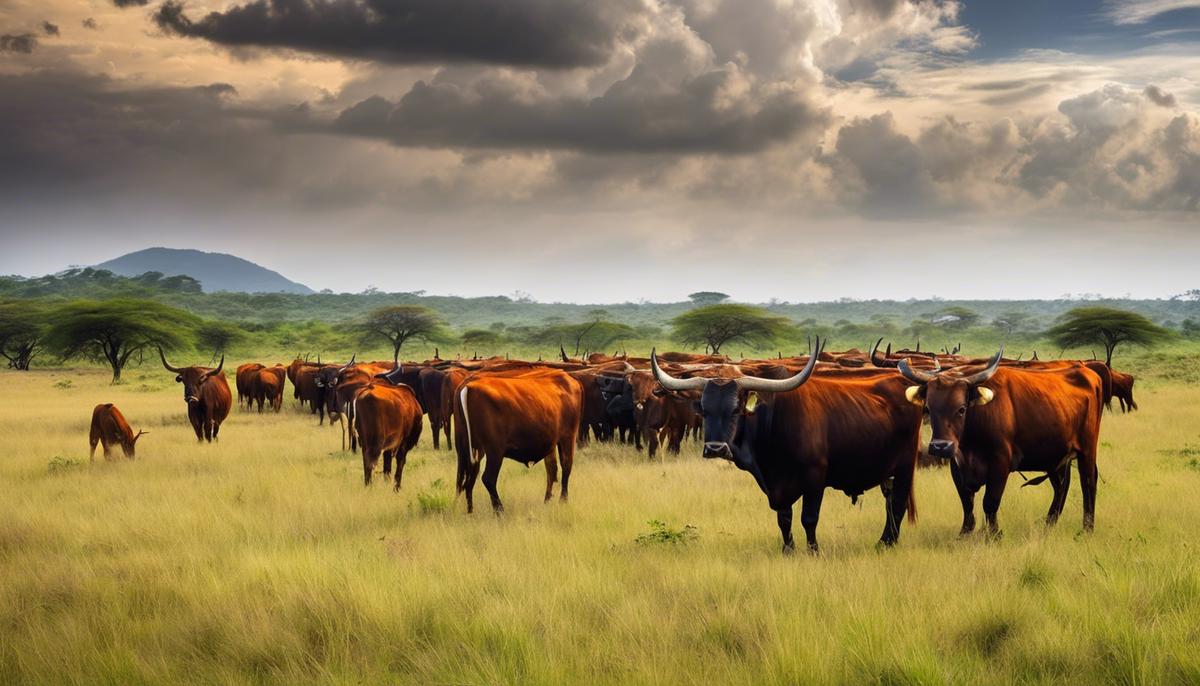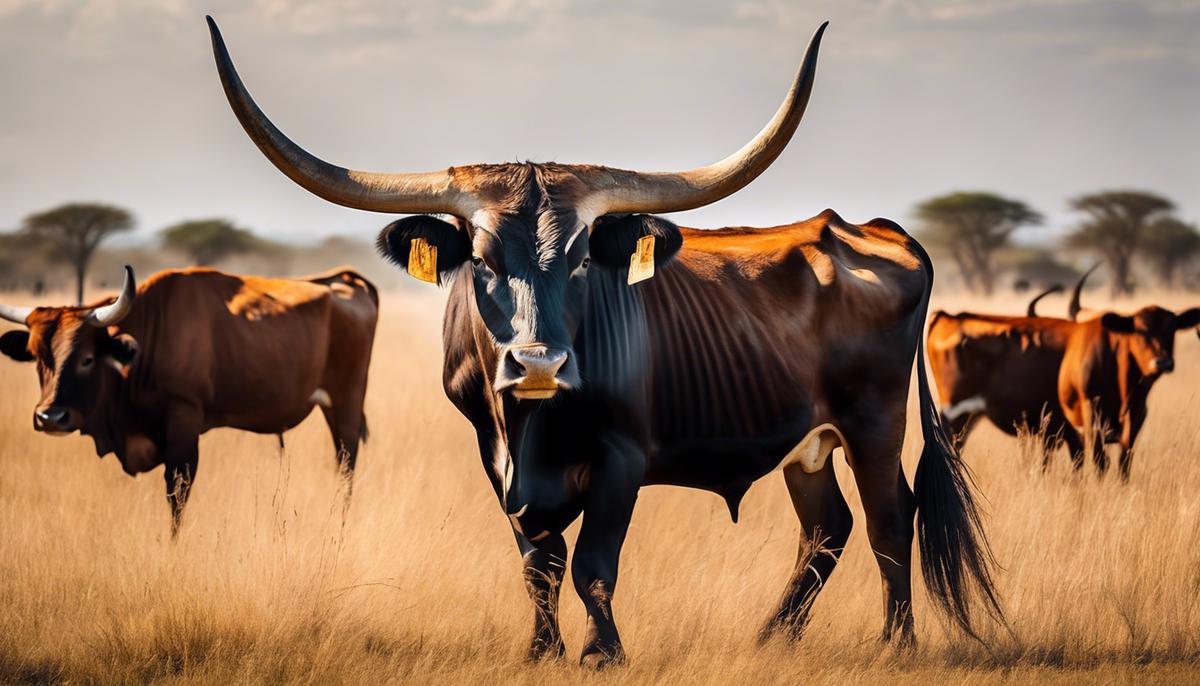
Ankole cattle horn
Description: Imposing and magnificent, the horns of Ankole cattle are more than just a striking sight. These unique structures, reaching lengths of up to eight feet, reflect a deeply interwoven relationship between biology, culture, economic activity, and conservation. The Ankole cattle, native to Africa, have evolved these gargantuan appendages that serve practical functions and simultaneously stand as grand symbols of cultural significance. An exploration into these facets provides an enlightening understanding into the rare magnificence that is the Ankole cattle horn. The topic of discussion for today’s discourse is the stately Ankole cattle, a bovine species native to Africa renowned for their extraordinary horns. This magnificent creature possesses horns of such veritable proportions that the average layman might find them implausible. The enormity of these curves of keratin provides a visually intriguing spectacle, but the ingenuity lies in the biological functionality they provide to these majestic creatures and their survival. The Ankole cattle, an inheritance from the Hamitic tribe of Northeast Africa, boasts a pair of horns that can reach lengths exceeding 8 feet from tip to tip. But to understand why this rare instance of gigantism exists, understanding the biological functional aspect is imperative. The horns, in essence, function as highly efficient body thermostats in the often intense African heat. Pedestrian onlookers will observe these structures as mere extravagantly designed headwear, but on closer inspection, it becomes clear that the chief utility of these horns is thermoregulation. As a biological adaptation to the arid conditions characteristic of the African savanna, these horns act as a conduit system for blood vessels. Inside the horn, a complex network of blood vessels winds up. These vessels contain blood which, as it circulates through the horns, dispels heat into the surrounding air. As a result, the animal’s internal temperature is maintained at a relatively constant level, providing some relief from the fierce African heat. Interestingly, upon closer examination, specific structural variations can be noted among the horns of different Ankole cattle. Many factors contribute to these differences, including genetic diversity, environmental conditions, and disease affliction. Such variations have been harnessed by local herders, who breed Ankole cattle selectively, valuing certain traits such as horn size, color, and shape, to accentuate the breed's aesthetic appeal and ecological adaptability. The involvement of these astonishing appendages extends beyond just thermoregulation for the Ankole cattle. They play a crucial role in the social lives of these bovines, significantly influencing dominance and hierarchy within the herd structure. An Ankole cow or bull with larger, more formidable horns is often perceived as a more dominant member of the herd. Consequently, this dominance translates into preferential access to resources such as food and mates, ensuring the survival and propagation of the most suitable genetic traits. Moreover, the presence of robust horns enables the Ankole cattle to thwart off predators effectively, safeguarding the health and longevity of the herd. This is particularly crucial in the African wilderness, teeming with formidable predators such as lions and hyenas. Understanding the remarkable biology of the Ankole cattle horn illuminates the fascinating world of adaptive evolution and serves as a testament to the diverse strategies employed by nature to ensure the survival of its creatures. This specific adaptation, a beautiful merger of form and function, characterizes the compelling story of survival, resilience, and evolution in the harsh realities of the African savannah. So, when marveling at the astounding sight of an Ankole cattle's great horns, one can now appreciate not just their aesthetic splendor, but also the intricate tale of adaptation and survival they symbolize. Taking it a notch further, it's important to delve into how these majestic creatures and their horns significantly influence the Framer and Gardner communities that raise them. Ankole cattle, popularly known as "cattle of kings," have shaped livelihoods, cultural identity, and symbology amongst these communities for generations and continue to affect their lives in profound ways. Economically, the Ankole cattle present a compelling model of agricultural sustainability. Their ability to survive in harsh conditions with minimal resources offers a reliable source of income for the farming communities. Aside from their meat and milk, the horns of the Ankole cattle are also a valuable commodity. Often hollowed out, these horns serve as containers for milk, honey, or even beer. Artisans revere them for their unique shape and size and often use them to create ornamental items, crafts, and musical instruments, providing an additional revenue stream for these communities. Culturally, the symbolism attached to these impressive horns runs deep. They are often seen as a symbol of strength, wealth, and social status. For instance, the larger and more symmetrical the horns, the more respect is attached to the owner within the community. For some, the number of cattle, particularly those with large, beautiful horns, determines the dowry in marriages, further underlining their cultural significance. Furthermore, the relationship between the cattle farmer and his Ankole cattle transcends purely economical bounds. In many tribes, these cattle are viewed as spiritual creatures, with their horns often featured in religious ceremonies, dances, and traditional rites. Songs and stories that instill moral values and societal norms to younger generations frequently feature these cattle, with their horns often representative of courage, resilience, and leadership. Given the magnitude of their cultural significance, it's no surprise that the Ankole cattle, particularly their horns, have left an indelible imprint on the region's visual art and craft traditions. From sculptural forms, pottery designs, to pictorial motifs in murals and textiles, the Ankole cattle horn has indeed become a symbol of African aesthetic expression and anthropological identity. In conclusion, the relationship between the Ankole cattle, their remarkable horns, and their farming communities provides a nuanced understanding of symbiosis between humans and nature. Through farming practices, cultural norms, symbolic attributions, and visual traditions, the Ankole cattle have indeed shaped the cultural identity of communities that raise them. Their figurative and cultural relevance, underscored by the aesthetic beauty and survival strategy inherent in their horns, truly stands testament to the adaptive genius of evolution. Delving into the economic impact of Ankole cattle horns, research notably indicates that they play a significant role in certain commercial sectors. The utility of these horns stretches notably beyond their biological functionality and influence on animal hierarchies, providing economic value in areas such as craftsmanship and tourism. Viewing the horns from the craftsmanship perspective, no components of the nonpareil Ankole cows go unused. Notably, their horns, with impressive lengths varying between 1.5 to 2.5 meters, provide an ample raw material for various crafting endeavours. Their size and natural curvature, along with their inherent durability, make them highly suitable for crafting objects such as bowls, musical instruments, buttons, and even pieces of furniture. For local artisans, these horns present an opportunity to thoroughly express their creativity while producing goods that have both functional and aesthetic value. The resultant crafted items not only provide a source of income for these artisans but also add an element of uniqueness to local markets, thus reinforcing the economic significance of Ankole cattle horns. On a broader view, the influence of Ankole cattle horns extends to shaping East Africa's visual art and craft traditions. Depictions of these cattle, their stunning horns extending like a halo, are a common motif in local art and crafts. Serving as symbols of beauty and strength, Ankole cattle and their horns represent an avenue for regional artists to connect their work to their cultural roots, while simultaneously catering to local and international markets. In the realm of tourism, Ankole cattle, often referred to as the "Cattle of Kings" due to their majestic appearance and long association with royal and ceremonial use, contribute to attracting both local and international visitors. Tourist sites that feature these cattle offer an intriguing peek into rich historic traditions and the importance of cows in East African societies. This particular form of agro-tourism assists in creating job opportunities and contributes tangibly to the local economy. Additionally, the sale of crafts made from Ankole cattle horns to tourists also boosts income in these regions. In essence, the immense horns of the Ankole cattle are much more than anatomical appendages. Exceeding their biological roles and cultural significance, they provide a basis for economic sustenance in traditionally rural societies, triggering a domino effect that benefits local artisans, supports local cultural expressions, and fuels the regional tourism industry. The impacts of Ankole cattle horns thus permeate various sectors, serving as a visual testament to a successful symbiosis between nature and economy. Delving into the heart of the matter, this article will probe the current conservation efforts dedicated to the preservation of Ankole cattle and the crucial element of ensuring sustainable farming practices for this remarkable breed. Owing to the profound impacts of crossbreeding and western farming practices, the presence of Ankole cattle has been on a declining trajectory for the past few decades. In response, numerous conservation programs have come into existence to safeguard their genetic diversity and to enlighten the global populace on the imperative need for their preservation. One notable effort is the establishment of the Ankole Cattle Conservation Project under Heifer Project International, which aims to maintain the purebred lines of these distinctive cattle while promoting their valuable traits. Moreover, the Global Farm Animal Conservation (FAnGR) is fostering efforts to catalogue and conserve the dwindling population of Ankole cattle. In collaboration with national institutions and farmer organizations, FAnGR's mission includes the development of Breeding Strategy Programmes that intertwine responsible breeding with the preservation of these majestic cattle. To amplify these recent endeavors, it is essential to expediently instill effective and sustainable farming practices on a global scale. This will potentially necessitate the dispelling of misconceptions about the relatively low productivity of Ankole cattle. In reality, the breed's adaptability to harsh climates, resistance to diseases, and low-maintenance characteristics support the prospects for sustainable farming. Within the scope of sustainable farming, the application of rotational grazing can contribute towards the mitigation of overgrazing, a key concern affecting the habitat of Ankole cattle. This practice can harmonize the balance between the cattle's grazing habits and the recovery period that the land necessitates, thereby preserving soil quality and maintaining grassland sustainability. Furthermore, incorporating community-led vestige programs can propel efforts to maintain the Ankole cattle population. These initiatives can kindle a sense of responsibility within local communities to preserve and nurture their herds. Exceptional examples of these practices can be identified in several East African communities, where Ankole cattle have an integral role ingrained within their socioeconomic frameworks. An overarching approach to secure the sustainability and preservation of Ankole cattle can be aided by bolstering the recognition of their value. In this quest, harnessing the power of technologies in genomic sciences can substantiate the agricultural, biological, and cultural significance of this distinctive breed. Such initiatives might inspire new avenues for public support and engagement, thus sparking an urgency towards preservation efforts. As the importance of biodiversity comes to the forefront, the unique and treasured attributes of Ankole cattle are being rediscovered. The commitment to ensuring their survival is not just about preserving a species, but about sustaining the agricultural, economic, and cultural value inextricably woven into their genes. In a broader perspective, it attests to our dedication towards harmony with nature, and the responsibility we behold to safeguard the myriad life forms that contribute to the rich tapestry of our planet's biological diversity. Through the Ankole cattle, one journeys into an intersection of biology, culture, economy, and sustainability. The portrayal of their unique, imposing horns is a testimony of nature’s grandeur and human ingenuity’s capacity to deploy it to socio-economic advantage. But amidst this celebration of these majestic creatures, echoes the call for conservation and sustainable measures to ensure their continuity. Ultimately, the story of the Ankole cattle and their resplendent horns is a narrative of coexistence and symbiosis - a vivid illustration of the intricate ties that bind nature, society, and economy.Ankole cattle horn
Biology and Function of the Ankole Cattle Horn
The Majestic Ankole Cattle: An Exploration of Their Distinctive Biology and Function
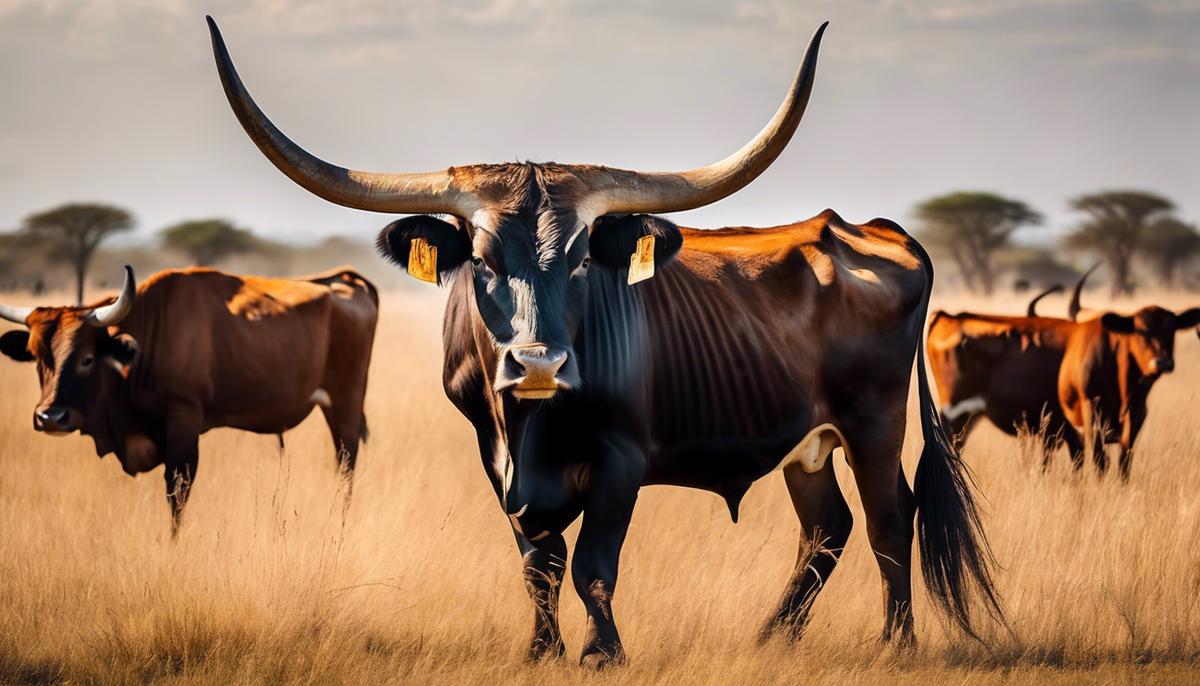
Influence on Local Communities and Culture | Ankole cattle horn
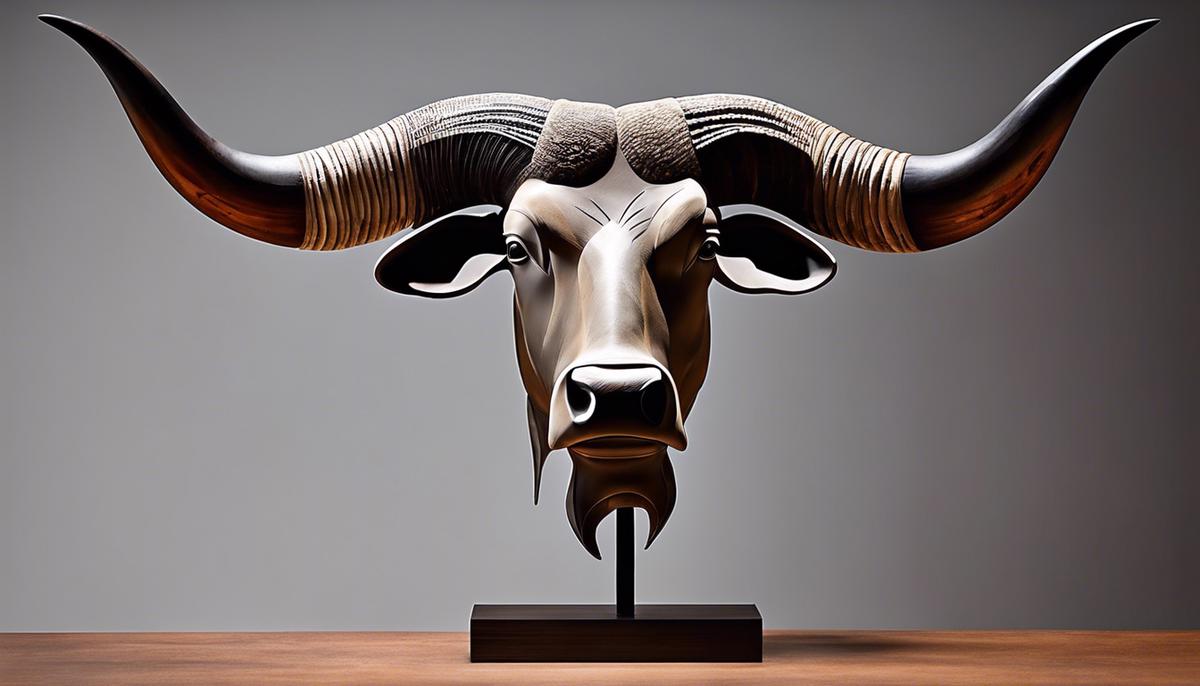
Ankole Cattle Horns in Economic Activity
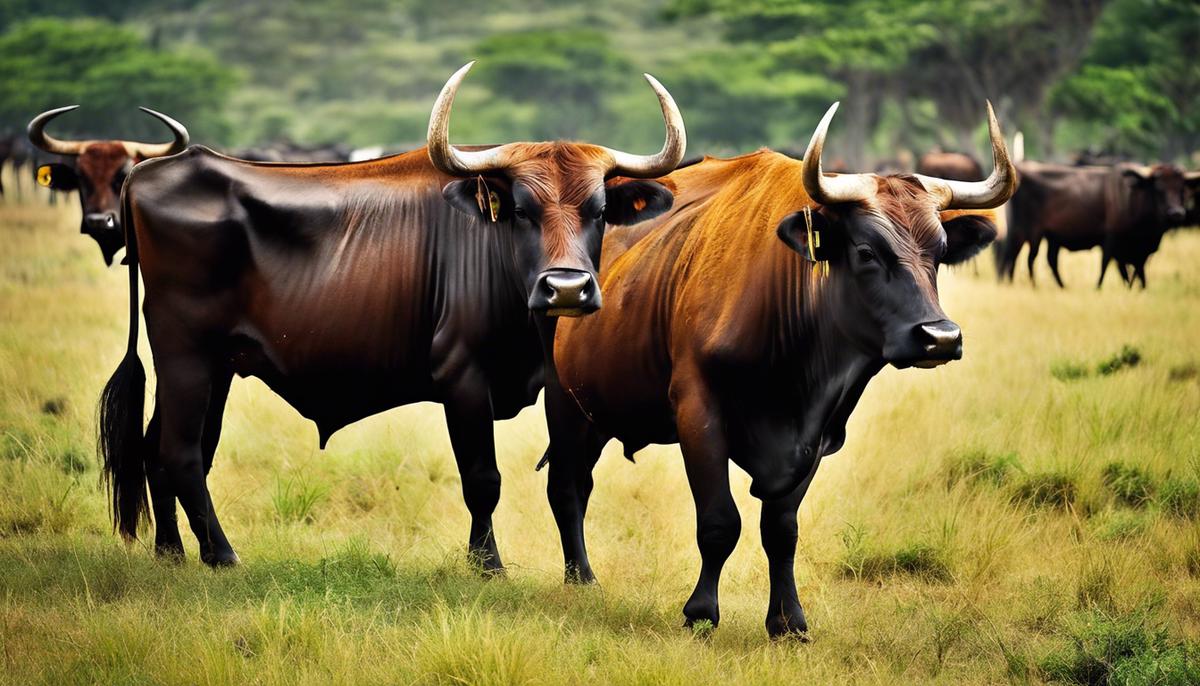
Conservation and Sustainability of Ankole Cattle horn
